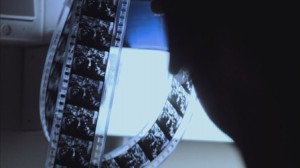 Jewdar may have a new definition of chutzpah: Sending your Holocaust-documentary to be reviewed by the magazine that is inarguably the Jewish world’s premier outlet for Holocaust humor. Granted, she doubtlessly didn’t know that the assignment would be handed off to Jewdar, the man responsible for much of the aforementioned humor; still, Yael Hersonski, director of A Film Unfinished, definitely has chutzpah. She also has a remarkable story to tell, and a fantastic documentary in which she tells it (and you thought we were going to misbehave, didn’t you?).
Jewdar may have a new definition of chutzpah: Sending your Holocaust-documentary to be reviewed by the magazine that is inarguably the Jewish world’s premier outlet for Holocaust humor. Granted, she doubtlessly didn’t know that the assignment would be handed off to Jewdar, the man responsible for much of the aforementioned humor; still, Yael Hersonski, director of A Film Unfinished, definitely has chutzpah. She also has a remarkable story to tell, and a fantastic documentary in which she tells it (and you thought we were going to misbehave, didn’t you?).
As one learns in the first minutes of the movie, back in May, 1942, the Nazis sent a film team to Warsaw to make a film about the Warsaw Ghetto. Footage was shot, placed in an archive for decades in a box marked “The Ghetto,” and largely ignored except for the occasional snippet used to jazz up a museum presentation here and there. Hersonski’s film, which was the big closer at this year’s Sundance Film Festival, presents an hour of the film in what is perhaps the most understated and intriguing documentary ever made about the Holocaust.
In doing so, Hersonski becomes one of two Israeli filmmakers in recent years who has transcended the boundaries of historical documentaries (though it should be noted that her method was perhaps fairly unique to her circumstances). One of the problems with such films is that, though they are presented as fact, there is an unavoidable falseness to them. You may film a somebody recalling an event, but, as a rule, you don’t have the specific event itself on film. You may show a recreation, or show stock footage from the event, but you don’t actually have the events as recalled by the witness himself. In Waltz With Bashir, filmmaker Ari Folman used animation to create a more realistic documentary style by eliminating the transition from recollection to representation: Everything is animated; hence, everything is equally synthetic and authentic.
Hersonski, however, was given a remarkable opportunity and made excellent use of it. While she also had interviews with survivors of the Warsaw Ghetto, getting their responses as they watched the Nazi film, much of the film’s narration comes from the diaries of Adam Czerniakow, head of the Warsaw Ghetto Judenrat, and the Nazis’ “go-to guy” for all things ghetto, including the setting up of the scenes to be filmed. We thus have, not only the film itself, but, in many cases, narration drawn from Czerniakow’s diary entries explaining what was happening in the film. Supplementing this are comments from the diaries of Emmanuel Ringelblum and an interview with Willy Wist, one of the original German cameramen.
The big question overhanging all of this is, What was the point of the film in the first place? As all accounts point out, and, as the film demonstrates, much effort was made into showing contrasts between “rich” and poor in the ghetto (we place the former in quotes because, even though the ghetto had its haves, the Nazi filmmakers staged grand balls and luxury settings for the film). Perhaps this was to demonstrate the perfidy of the Jews, that the rich Jews were unconcerned by the poverty around them. Or maybe the luxurious settings were designed to highlight how well-treated the Jews were. But the timing is strange. The Final Solution had already been decided upon at roughly the same time the film crew was operating, and the ultimate destination of Warsaw’s Jews was already being established in Treblinka. So for whom was this film being made, and why?
Jewdar doesn’t know if we have the answer, but one segment in particular struck us, when the Jews were ordered to stage various Jewish rituals: circumcisions, kosher slaughter, even immersion in the mikva by both men and women. Watching the footage, and, knowing what the Nazis had in mind for their subjects, it’s hard to escape fully the conclusion that this film ultimately wasn’t propaganda but anthropology–the Nazis making a video record of the quaint customs and rituals of what were supposed to be Europe’s last Jews in their natural habitat.
Whatever the truth, A Film Unfinished is a must-see for anyone interested in the Holocaust, and how often does Jewdar say that about a Holocaust film that doesn’t star Jerry Lewis?
A Film Unfinished opens in select theaters August 18.



I think you are quite correct that the Nazis were engaged in their inverted, sick and distorted idea of “anthropology” – as they planned to create a Musuem of Extinct Peoples – with Jews prominent among them – if they had won and had (God Forbid!) completed their genocidal project. It was anti-anthropology – the very antithesis of what anthropology is supposed to do – elevate humanity through a dignified exploration of cultural differences AND an acknowledgment of human cultural universals.